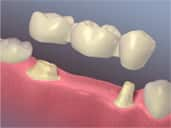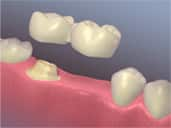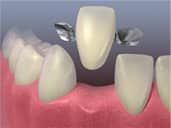As many of us know, when you have a missing tooth, it can be difficult to communicate, speak, bite or even eat effectively. When a tooth is missing, it is essential to visit your dentist to discuss the dental options for replacement.
Dental bridges are utilized in dentistry to replace the missing teeth and provide a bridge that connects the adjoining teeth. The teeth on either side of the missing tooth are called abutment teeth and the replacement tooth is called the pontic (false tooth).
Why are Bridges Important?
Dental bridges will help restore your smile and maintain the appropriate face shape. They can also help you properly chew food, speak and place the jaws together when biting, which helps prevent other teeth in the mouth from moving out of place or drifting apart.
What Type of Dental Bridges Can I Choose From?
The three most common types of dental bridges include:

1. Traditional Bridge — this is the most popular type of bridge used in dentistry and is made from ceramics or porcelain fused to metal. A dental crown is made for the teeth on either side of the missing tooth (abutment teeth) with a pontic in between them.

2. Cantilever Bridge — this is utilized when the patient does not have two teeth on either side of the missing tooth. The abutment teeth adjacent to one another are prepped and the pontic is attached to the end of it.

3. Maryland Bridge — this bridge is made from a metal framework where the pontic (false tooth) is attached to the metal or porcelain wings that are cemented to the two abutment teeth. This bridge is a conservative alternative to a traditional bridge.
How Much Do They Cost and How Long Will They Last?
The average cost of a dental bridge can range in price based upon the number of units and the area of the country you live in. Most dental insurance policies will cover a portion of the cost. Dental bridges can last many years if properly maintained through professional check-ups and cleanings.
What Will My Dental Appointments Be Like?
On the first appointment, the dentist will begin to remove the enamel structure of the abutment teeth to prepare the teeth for a crown. Then impressions of your teeth will be taken and the dental bridge, crowns and pontic will be created by your dentist’s dental laboratory. Your dentist will make a temporary bridge to be worn while your permanent bridge is being made.
At the next appointment, the temporary bridge will be removed and the new permanent bridge will be placed onto the area and checked for proper fit. There may be more than one visit to ensure that the permanent bridge fits securely in the mouth.
Maintaining Your Dental Bridge
The permanent bridge is cared for like your permanent teeth. The bridge should be cleaned properly in between the teeth and pontic using a proxybrush and/or dental floss. Proper brushing twice a day with fluoride toothpaste is also important.
Cleaning your bridge will help to reduce cavities and the development of inflammation of the gum tissue. Please see your dental professional for a regular check-up and professional cleaning appointment
© Copyright Colgate-Palmolive Company 2010





